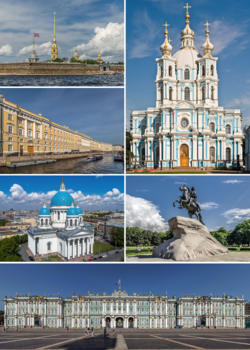Saint Petersburg

Saint Petersburg (Russian: Санкт-Петербу́рг, tr. Sankt-Peterburg, IPA: [ˈsankt pʲɪtʲɪrˈburk] ( listen)) is Russia's second-largest city after Moscow, with 5 million inhabitants in 2012, part of the Saint Petersburg agglomeration with a population of 6.2 million (2015). An important Russian port on the Baltic Sea, it has a status of a federal subject (a federal city).
Situated on the Neva River, at the head of the Gulf of Finland on the Baltic Sea, it was founded by Tsar Peter the Great on May 27 [O.S. 16] 1703. On 1 September 1914, the name was changed from Saint Petersburg to Petrograd (Russian: Петрогра́д, IPA: [pʲɪtrɐˈgrat]), on 26 January 1924 to Leningrad (Russian: Ленингра́д, IPA: [lʲɪnʲɪnˈgrat]), and on 7 September 1991 back to Saint Petersburg. Between 1713 and 1728 and in 1732–1918, Saint Petersburg was the capital of Imperial Russia. In 1918, the central government bodies moved to Moscow, which is about 625 kilometres (388 mi) to the south-east.
Saint Petersburg is one of the modern cities of Russia, as well as its cultural capital. The Historic Centre of Saint Petersburg and Related Groups of Monuments constitute a UNESCO World Heritage Site. Saint Petersburg is home to the Hermitage, one of the largest art museums in the world. Many foreign consulates, international corporations, banks and businesses have offices in Saint Petersburg.


